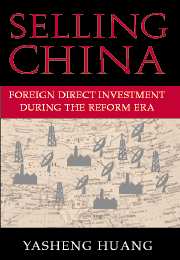Book contents
- Frontmatter
- Contents
- List of Tables and Figures
- List of Abbreviations
- Synopsis of the Book
- Preface
- Selling China
- 1 Introduction
- 2 An Analytical Framework
- 3 Problems in China's Corporate Sector
- 4 Constraints on Nonstate Firms and Foreign Direct Investment
- 5 State-Owned Enterprises and Insolvency-Induced Foreign Direct Investment
- 6 Economic Fragmentation and Foreign Direct Investment
- 7 Conclusion
- Bibliography
- Index
1 - Introduction
Published online by Cambridge University Press: 05 June 2012
- Frontmatter
- Contents
- List of Tables and Figures
- List of Abbreviations
- Synopsis of the Book
- Preface
- Selling China
- 1 Introduction
- 2 An Analytical Framework
- 3 Problems in China's Corporate Sector
- 4 Constraints on Nonstate Firms and Foreign Direct Investment
- 5 State-Owned Enterprises and Insolvency-Induced Foreign Direct Investment
- 6 Economic Fragmentation and Foreign Direct Investment
- 7 Conclusion
- Bibliography
- Index
Summary
In a New York Times article entitled, “Funny, I Moved to Beijing and Wound Up in Pleasantville,” Elisabeth Rosenthal, Times reporter in China, provides a humorous account of a typical weekend outing in Beijing. She describes driving her kids to a soccer game in a sports-utility vehicle (most probably made by Beijing Jeep, a joint venture, or JV, with DaimlerChrysler), loading up on toilet paper supplies at Price Smart, stopping by one of the over forty McDonald's in Beijing for a Big Mac, and Dairy Queen or Baskin-Robbins for a sundae. She writes, “So this is what the Communist Party means by ‘socialism with Chinese characteristics’! But isn't this what it's like in Des Moines?”
To elevate – or, depending on one's view, to denigrate – Beijing all the way to Des Moines is arguably a sign of one of the hallmark events in modern times: China's integration into the world economy. Foreign firms, either singly or as JVs with Chinese firms, have established a ubiquitous presence in China. Rosenthal could also have mentioned that on China's congested streets, the indisputable king of the road is the Santana, a sedan with a 1970s' look and a 1980s' engine design. The Santana is assembled in Shanghai by a JV with Volkswagen. In 1998, for every 100 passenger cars sold in China, forty-eight were Santanas.
- Type
- Chapter
- Information
- Selling ChinaForeign Direct Investment During the Reform Era, pp. 1 - 64Publisher: Cambridge University PressPrint publication year: 2002



